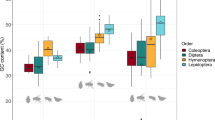Abstract
Insect genome size diversity remains poorly sampled, with sparse and sporadic sampling of a few select orders and with many orders unrepresented or underrepresented in the genome size database. Here, we present 134 genome size estimates for 18 orders, including the first ever genome size estimates for eight orders, 38 families, 102 genera, and 131 species. Also reported here are three insect species genome size estimates that are corrections for unpublished genome size values that made it into the literature, including the smallest arthropod genome of the two spot spider mite (1C = 91 Mb). These estimates range from 91 to 7,752 Mb and provide a broader picture of genome size variation within Insecta and among all Arthropods. Proposed developmental constraints for holometabolous insect genome sizes are supported, with the majority of the species examined falling well under the hypothesized 1,978 Mb (2 pg) limit. The only exceptions occur in the highly diverse beetles (Coleoptera) (154 < 1C < 2,578) and the Mecoptera (1,890 < 1C < 2,134). Hemimetabolous orders include species with larger genomes. Of these, the Orthopteran genomes remain the largest (675 < 1C < 7,752). Hemipteran genomes are smaller (407 < 1C < 1,230), but with a very notable exception, the Cicadidae family, with bloated genomes (5,238 < 1C < 7,000 Mb) of a size previously known to exist only within Orthoptera. The genome sizes in all other Hemimetabolous orders (521 Mb < 1C < 3,860 Mb) fall within the range exhibited by the Hemiptera. New preparations and procedures for insect genome estimates with frozen material are described and discussed. To further improve and extend the number and quality of arthropod genome size estimates, a new flow cytometry insect standard, Blattaria: Periplaneta americana♂ (1C = 3,338 Mb) is established for genome size determination of insect genomes in excess of 2,000 Mb.




Similar content being viewed by others
Abbreviations
- CRBC:
-
Chicken Red Blood Cells - Gallus gallus domesticus
- DNA:
-
Deoxyribonucleic acid
- Mb:
-
Megabases
- Mya:
-
Million years ago
- PAM:
-
Periplaneta americana
- TAMU:
-
Texas A&M University
References
AgriLife Extension Texas A&M System (2011) American cockroach. http://insects.tamu.edu/fieldguide/aimg22.html
Brusca RC, Brusca GJ (2003) Invertebrates. Sinauer Associates, Sunderland
DeSalle R, Gregory TR, Johnston JS (2005) Preparation of samples for comparative studies of arthropod chromosomes: visualization, in situ hybridization, and genome size estimation. Methods Enzymol 395:460–488
French CK, Manning JE (1980) DNA sequence organization in the Thysanura Thermobia domestica. J Mol Evol 15:277–289
Galbraith DW, Harkins KR, Maddox JM, Ayres NM, Sharma DP, Firoozabady E (1983) Rapid flow cytometric analysis of the cell cycle in intact plant tissues. Science 220:1049–1051
Gaston KJ (1991) The magnitude of global insect species richness. Conserv Biol 5:283–296
Gatehouse JA, Price ARG (2011) Protection of crops against insect pests using RNA interference. Insect Biotechnology Biol Inspir Syst 2(Part 2):145–168
Grbic M, Khila A, Lee KZ, Bjelica A, Grbic V et al (2007) Mity model: Tetranychus urticae, a candidate chelicerate model organism. Bioessays 29:489–496
Gregory TR (2001) Coincidence, coevolution, or causation? DNA content, cell size, and the C-value enigma. Biol Rev Camb Philos Soc 76(1):65–101
Gregory TR (2002) Genome size and developmental complexity. Genetica 115(1):131–146
Gregory TR (2005) Evolution of the genome. Elsevier, Amsterdam
Gregory TR (2011) Animal genome size database. http://www.genomesize.com
Gregory TR, Johnston JS (2008) Genome size diversity in the family Drosophilidae. Heredity 101:228–238
Grimaldi DA, Engel MS (2005) Evolution of the insects. Cambridge University Press, Cambridge
Hare EW, Johnston JS (2011) Genome size determination using flow cytometry. In: Orgogozo V, Rockman M (eds) Molecular methods for evolutionary genetics. Humana, New York
Johnston JS, Ross LD, Beani L, Hughes DP, Kathirithamby J (2004) Tiny genomes and endoreduplication in Strepsiptera. Insect Mol Biol 13:581–585
Johnston JS, Yoon KS, Strycharz JP, Pittendrigh BR, Clark JM (2007) Body lice and head lice (Anoplura: Pediculidae) have the smallest genomes of any hemimetabolous insect reported to date. J Med Entomol 44(6):1009–1012
Kraaijeveld K (2010) Genome size and species diversification. Evolutionary Biol 37:227–233
Nolan T, Papathanos P, Windbichler N, Magnusson K, Benton J, Catteruccia F, Crisanti A (2011) Developing transgenic Anopheles mosquitoes for the sterile insect technique. Genetica 139:33–39
Schmidt-Ott U, Ab MR, Sander K, Johnston JS (2009) Extremely small genomes in two unrelated dipteran insects with shared early developmental traits. Dev Genes Evol 219:207–210
Sharaf K, Horová L, Pavlíček T, Nevo E, Bureš P (2010) Genome size and base composition in Oryzaephilus surinamensis (Coleoptera: Sylvanidae) and differences between native (feral) and silo pest populations in Israel. J Stored Prod Res 46(1):34–37
Swift H, Kleinfeld R (1953) DNA in grasshopper spermatogenesis, oögenesis, and cleavage. Physiol Zool 26:301–311
Whiting MF (2002) Mecoptera is paraphyletic: multiple genes and phylogeny of Mecoptera and Siphonaptera. Zoologica Scripta 31(1):93–104
Wiegmann BM, Trautwein MD, Kim JW, Cassel BK, Bertone MA, Winterton SL, Yeates DK (2009) Single-copy nuclear genes resolve the phylogeny of the holometabolous insects. BMC Biol 7:34. doi:10.1186/1741-7007-7-34
Acknowledgments
We would like to thank Ed Riley of the Texas A&M Insect collection for the identification of many of the species in this paper and an NHGRI subcontract from the Washington University Genome sequencing Center for support.
Author information
Authors and Affiliations
Corresponding author
Additional information
Responsible Editor: T. Ryan Gregory and Jillian D. Bainard
Rights and permissions
About this article
Cite this article
Hanrahan, S.J., Johnston, J.S. New genome size estimates of 134 species of arthropods. Chromosome Res 19, 809–823 (2011). https://doi.org/10.1007/s10577-011-9231-6
Published:
Issue Date:
DOI: https://doi.org/10.1007/s10577-011-9231-6




